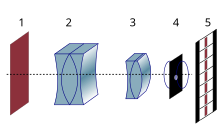Anamorphic
An anamorphic lens is a lens that produces an anamorphic image and is sometimes referred to as an "anamorphoscope".
With the help of an optical system that creates image scales of different sizes in two mutually perpendicular directions, a distorted image is created that is referred to as anamorphic .
An anamorphic lens consists of at least three cylinder lenses , two cylinder mirrors or a prism system . As a result, the optically generated image is stretched or compressed in one direction relative to the other. As a rule, however, a single such individual optical element is not sufficient, since the sharp image planes for both the horizontal and the vertical planes must both lie in the film plane.
Anamorphic lenses are used for cinema films in the anamorphic process ( CinemaScope , Panavision , Superscope, etc.). An anamorphic image in the camera is used to compress the image to the existing, fixed, predetermined raw film format, and one in front of the projector is used for rectification on the screen. In the past, anamorphic lenses were also offered as attachment lenses for existing film cameras. The pioneer in this area was the company Kish Optics from the USA. It continues to be for cinema projectors and video projectors. The film camera manufacturer ARRI has also perfected the system with the so-called MScope process for digital recording. Anamorphic lenses are used to record on a 4: 3 chip and rectify in post-production.
In addition, anamorphic lenses are used to symmetrize the elliptical beam profile of lasers or laser diodes.
In the technical data of anamorphic lenses, the compression ratio is given, i.e. that is, to what extent the image is compressed or expanded. Common ratios are factor 2 (for CinemaScope films - this results in an aspect ratio of 2.35: 1 or more precisely 2.40: 1), factor 1.5 (cinema aspect ratio 1.85: 1) and factor 1.33 (turns a 4: 3 picture into a 16: 9 picture - used for HD digital / video recordings).
Typical suppliers of anamorphic camera lenses are Optika Elite from Russia or the German company Vantage (16: 9 and 2.40: 1) and Kowa from Japan. The German company ISCO is again developing an anamorphic auxiliary lens with which it will be possible to use conventional film camera lenses as cinemascope lenses. ISCO and Schneider Kreuznach also offer anamorphic lenses for cinema projection.
